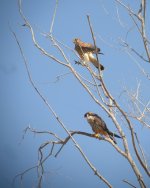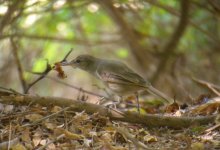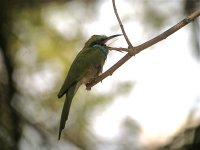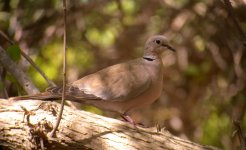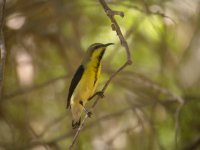MKinHK
Mike Kilburn

A three-day work trip took me to Abu Dhabi in the United Arab Emirates just as autumn migration was kicking in. My birding was limited to a coffee break and an evening walk close to the Hilton Hotel (there are two – mine was in the East of the city near the football stadium), and the morning before my flight in the park around Mushrif Palace Gardens.
The coffee break was a quick 20 minutes in a grove of trees alongside an eight-lane highway. It was still nicer than my Magic Roundabout patch at Hong Kong Airport as there were no planes or trains, and the lawn and leaf litter under the trees was not strewn with rubbish or swarms of mosquitoes. The first birds were a recently fledged Common Myna loudly demanding food from its parents, and a fine Hoopoe that came up off the grass, perched and regally rolled its crest for the highly appreciative crowd (of one). A White-cheeked Bulbul displayed a Great Tit-like black frame to its pure white cheeks. They are smart birds, especially in flight from below, when they show a fine array of roundwhite spots on the end of each tail feather and a bright yellow vent.
A tree with lots of thin spiky branches and small leaves was home to a drab-looking sunbird. In other parts of the world this would be an ID nightmare, but happily Abu Dhabi limits itself to just the one – Palestine Sunbird – which has a shrill and easily identified call. Not so straightforward was a large hippo/accro with a short-looking tail. My best guess is the resident Eastern Olivaceous Warbler but I was never going to be able to do much with naked-eye views of a warbler hiding high in the foliage.
There were also two or three House Sparrows, a couple of Collared Doves, and best of all a Graceful Prinia which helpfully clambered down to eye level to check me out. On the way back a scruffy-looking dark-headed bulbul turned out to be Sooty-headed Bulbul an introduced species in the Emirates.
That evening the park across the road was rather less productive. A Eurasian Kestrel circled over my head and some 20 Ring-necked Parakeets dropped into the tall trees to roost. The highlight was watching twenty or so White-cheeked and Sooty-headed Bulbuls feeding on newly emerging flies. The flies were hovering a few feet above the tops of the trees and each bulbul would fly straight up, catch a fly, and then pivoting on its tail, tip over and drop back to its tree.
Cheers
Mike
The coffee break was a quick 20 minutes in a grove of trees alongside an eight-lane highway. It was still nicer than my Magic Roundabout patch at Hong Kong Airport as there were no planes or trains, and the lawn and leaf litter under the trees was not strewn with rubbish or swarms of mosquitoes. The first birds were a recently fledged Common Myna loudly demanding food from its parents, and a fine Hoopoe that came up off the grass, perched and regally rolled its crest for the highly appreciative crowd (of one). A White-cheeked Bulbul displayed a Great Tit-like black frame to its pure white cheeks. They are smart birds, especially in flight from below, when they show a fine array of roundwhite spots on the end of each tail feather and a bright yellow vent.
A tree with lots of thin spiky branches and small leaves was home to a drab-looking sunbird. In other parts of the world this would be an ID nightmare, but happily Abu Dhabi limits itself to just the one – Palestine Sunbird – which has a shrill and easily identified call. Not so straightforward was a large hippo/accro with a short-looking tail. My best guess is the resident Eastern Olivaceous Warbler but I was never going to be able to do much with naked-eye views of a warbler hiding high in the foliage.
There were also two or three House Sparrows, a couple of Collared Doves, and best of all a Graceful Prinia which helpfully clambered down to eye level to check me out. On the way back a scruffy-looking dark-headed bulbul turned out to be Sooty-headed Bulbul an introduced species in the Emirates.
That evening the park across the road was rather less productive. A Eurasian Kestrel circled over my head and some 20 Ring-necked Parakeets dropped into the tall trees to roost. The highlight was watching twenty or so White-cheeked and Sooty-headed Bulbuls feeding on newly emerging flies. The flies were hovering a few feet above the tops of the trees and each bulbul would fly straight up, catch a fly, and then pivoting on its tail, tip over and drop back to its tree.
Cheers
Mike




